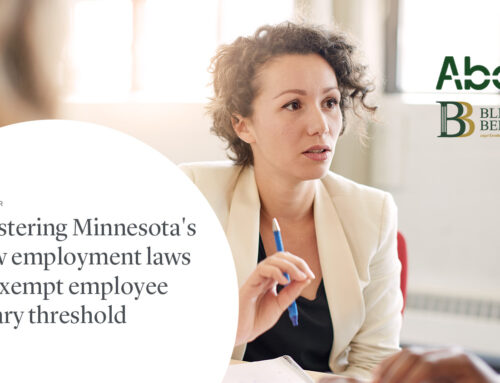With more school districts transitioning to distance learning and more employees being absent for isolation, quarantine and testing, we wanted to provide you a refresher regarding the Families First leave that is available to many employees. Here are a few things to remember:
1. Families First is still in effect. The Families First Act went into effect on April 1, 2020, and is currently set to expire on December 31, 2020. It applies to employers with less than 200 employees. Congress could extend it but hasn’t done so yet.
2. Families First Paid Sick Leave. Full time employees must be granted 80 hours of paid sick leave for COVID-related purposes (Part-time employees must be granted paid sick leave equal to the number of hours that the employee works on average over a two-week period). There is no length of employment requirement for this paid sick leave benefit.
Employees eligible for Families First leave for the following reasons are entitled to pay at either their regular rate or the applicable minimum wage, whichever is higher, up to $511 per day and $5,110 in the aggregate (over a 2-week period) and can use this paid sick leave if the employee is unable to work because the employee:
- Is subject to a Federal, State, or local quarantine or isolation related to COVID-19;
- Has been advised by a health care provider to self-quarantine related to COVID-19
- Is experiencing COVID-19 symptoms and is seeking a medical diagnosis (this includes getting tested and awaiting results);
Employees eligible for Families First leave for the following reasons are entitled to pay at 2/3 their regular rate or 2/3 the applicable minimum wage, whichever is higher, up to $200 per day and $2,000 in the aggregate (over a 2-week period) and can use this paid sick leave if the employee is unable to work because the employee:
- Is caring for an individual subject to an order described in (a) or self-quarantine as described in (b); or
- Is caring for a child (under 18 years old) whose school or childcare provider is closed or unavailable for reasons related to COVID-19.
The US Center for Disease Control still generally recommends a 14 day quarantine for people who were exposed to someone diagnosed with COVID-19, but it has shortened the recommendation to 10 days without symptoms and 7 days without symptoms and a negative test to give employees more options to return to work sooner (provided that the test was a PCR test and not a rapid test).
3. Families First FMLA Leave. Employees who have been employed for at least 30 calendar days are entitled to up to twelve weeks of paid expanded family and medical leave at 2/3 of their regular rate of pay up to $200 per day and $12,000 in the aggregate (over a 12-week period) to care for a child (under 18 years old) whose school or childcare provider is closed or unavailable for reasons related to COVID-19. The first ten days of this leave are unpaid, but the employee may elect to use their Families First paid sick to substitute paid leave for the unpaid leave, if the employee has it available. If the employee has already used their Families First sick leave bank, the first ten days are unpaid unless the employee chooses to substitute other available paid leave (such as other sick leave, vacation or PTO) for the unpaid portion of the leave. As a reminder, this leave currently expires on December 31, 2020 and is not required to be made available to employees after that date, absent an extension from Congress.
4. Schools that have transitioned to distance learning are considered “closed” under Families First. A school is considered “closed” under the act if the physical location where kids receive instruction is closed, even if the school has transitioned into a distance learning model. A school is not considered closed if the family chooses to keep their child in a distance learning model but an in-person or hybrid model is available.
5. Duration of leave. For employees requesting Families First FMLA leave to care for a child whose school or place of care is closed (or child care provider is unavailable) for reasons related to COVID-19:
- A full-time employee is eligible for up to 12 weeks of leave at 40 hours a week through December 31, 2020; and
- A part-time employee is eligible for leave for the number of hours that the employee is normally scheduled to work over that period.
6. Families First leave is cumulative. Any Families First sick or FMLA leave an employee has already taken counts against their cap, so make sure you’re looking all the way back to April 1st to determine eligibility.
7. Don’t forget about the tax credits! You can fund Families First leave with federal tax credits. This is a benefit that doesn’t get as much coverage as other aspects of the Act but can have a big impact on employers because it provides a potential pool from which to fund the leave. In anticipation of being able to claim the credit associated with leave, an employer can use the federal income tax they have withheld (and the employees’ share of social security and Medicare taxes, and the employer’s share of social security and Medicare taxes) to pay for the leave. This is a link to the IRS’ FAQ page regarding the tax credits.
8. There is a small business exemption. Employers with fewer than 50 employees may qualify for an exemption to the leave related to school or closure or child care unavailability if providing the leave would “jeopardize the viability of the small business as a going concern.” It is important to note that this is not a blanket exception for employers with less than 50 employees; each employee must be looked at individually, and some may be exempt while others are not.
For an employee requesting Families First leave to be exempt, an individual analysis of that employee’s skill, knowledge, and abilities AND the current economic factors affecting the employer must be completed. One of the three exemptions below that might apply to one employee, might not apply to others. The DOL provides three possible small-employer exceptions from the Families First leave. To be exempt from the Families First Leave requirements, an “authorized officer” of the business must determine:
- The requested leave would result in the business’ expenses and financial obligations exceeding business’ revenues AND cause the business to cease operating at a minimal capacity (i.e. the business can’t afford to pay for the employee’s covered leave); or
- The absence of the employee requesting the leave would entail a substantial risk to the financial health or operational capabilities of the business because of his or her specialized skill, knowledge of the business, or responsibilities; (i.e. the employee requesting the leave is one of the only employees that performs a specialized job function); or
- There are not sufficient workers who are able, willing, and qualified, and who will be available at the time and place needed, to perform the labor or services provided by the employee or employees requesting leave and these labor or services are needed for the small business to operate at a minimal capacity (i.e. the business won’t be able to operate if its employees are on leave).
9. You can provide more leave than Families First requires. Employers are free to provide more leave than is required under Families First. You are able provide leave for employees who don’t meet the requirements for Families First leave, who have already exhausted their Families First leave if you choose to do so, but you can’t claim tax credits for it.
10. Flexible work options are recommended. Although this leave is available, the DOL supports and encourages flexible working arrangements to allow employees to continue to work as best as possible while caring for their child or in quarantine. If remote or teleworking is a possibility, or if employers and employees can agree to an intermittent leave on a day-by-day basis, those voluntary arrangements should be pursued.
11. Record keeping is essential. We recommend that an employer keep records of all requests for Families First paid sick leave or expanded FMLA leave, regardless of whether the request was granted or denied. These records are important to prove your compliance with the Families First Act and will be used for reimbursement of the costs of the leave through refundable tax credits. Employers should document the following:
- The name of the employee requesting leave;
- The date(s) for which leave is requested;
- The reason for leave;
- A statement from the employee that he or she is unable to work because of the reason; and
- The compensation during the leave;
- Whether or not the leave is granted and the dates of the leave, including the expected return date for the employee. If flexible work arrangements are made, those too should be documented.
The FMLA requires an employer to provide an eligible employee with certain notices regarding leave, so it is important to document the grant or denial of Families First FMLA leave requests for the employee’s personnel record, as well.
If an employee requests leave because he or she is subject to a quarantine or isolation order or to care for an individual subject to such order, you should additionally document the name of the government entity that issued the order. If an employee requests leave to self-quarantine based on the advice of a health care provider or to care for an individual who is self-quarantining based on such advice, you should document the name of the health care provider.
For employees requesting leave to care for a child whose school or place of care is closed, or child care provider is unavailable you must also document:
- The name of the child being cared for;
- The name of the school, place of care, or child care provided that has closed or become unavailable; and
- A statement from the employee that no other suitable person is available to care for the child.
If you have questions about Families First and how to comply with its provisions, questions that are arising due to the impacts of the COVID-19 on your business, or any other employment law issues, please contact one of our employment law attorneys, Julia Ketcham Corbett, Beth Serrill, or Alyssa Nelson. We will continue to support you as we all navigate these challenging and uncertain times.


